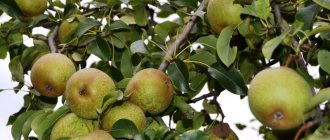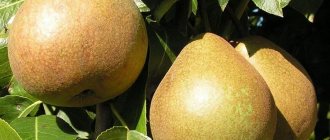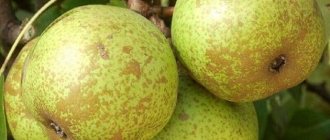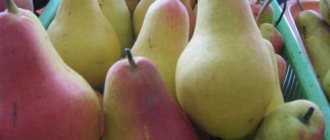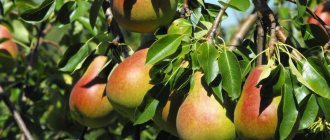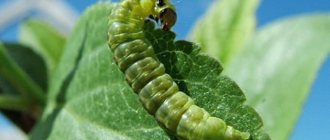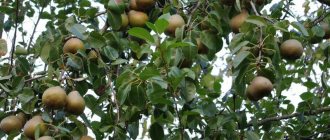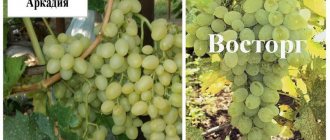History of selection
Red-sided pear is a variety created in the Ural branch of the Academy of the Russian Academy of Sciences. The originator is the Ural Agrarian Research Center. The work of a team of breeders began in the mid-70s of the last century; stability of varietal characteristics was achieved only in the early 90s. The “parents” were the varieties Tenderness and Zheltoplodnaya.
An application for registration of a pear called "Red-sided" was submitted in 1992. The variety was included in the Russian State Register of Breeding Achievements only ten years later.
Description of the Red-sided pear with photo
Externally, the tree is practically no different from its “relatives”. However, the variety immediately stands out for its presentability and large fruit size.
Tree
Red-sided pear is a tree of medium height (up to 4 m). The growth rate immediately after planting is quite high, but after the first fruiting it slows down sharply. The crown has a regular round shape and is sparse. The leaves are large, with a pronounced corrugated surface.
Most of the tree's branches are noticeably curved; they extend from the trunk at an angle close to a straight line.
Fruit
The fruits of Krasnobokaya are classically pear-shaped, unusually large for the Urals (weighing 150-180 g). One-dimensionality and symmetry add to their presentability.
The color of the peel of unripe fruits is light green. As they ripen, it changes to greenish-yellow. In those places where the fruits are exposed to sunlight, blurry spots of pinkish or crimson “blush” of varying degrees of intensity appear.
The skin is thin and tender, you can hardly feel it when eating
Important! Most of the fruits are formed on the ringlets and fruit twigs, as well as towards the end of the shoots (approximately in the last quarter).
The pulp is tender and “buttery” in texture, despite the presence of a pronounced “graininess” on the cut. The shade varies from almost white to yellowish-cream.
Chemical composition
It is worth eating a pear with the peel, it contains the most useful substances. It is better to eat hard pears. The more ripe the fruit, the more sugar it contains, and the less beneficial pectins and fruit acids.
| Nutritional properties of pear: | Vitamin content: |
|
|
Characteristics of the red-sided pear
One of the main varietal characteristics of the Red-sided pear, which distinguishes it from among its “relatives” and has a great influence on the choice of gardeners, is the taste of the fruit. But before planting, you need to familiarize yourself with its other properties.
Tasting evaluation of Red-sided pear
In terms of taste, the Red-sided pear may well compete with other varieties and hybrids that are more picky about the climatic conditions in the cultivation region. The pulp is distinctly sweet, with a slight “balancing” sourness, without which it would seem “fresh,” and an almost imperceptible tartness.
The pronounced pear aroma is preserved after heat treatment in any homemade preparations and wines
Important! Professional tasters rate the taste of the Red-sided pear 4.5 points out of a possible five.
Ripening time
Contrary to popular belief, Red-sided is not a winter, but a late-autumn pear variety. It is removed from the tree slightly unripe because ripe fruits quickly fall off, and not so that the fruits gradually ripen by December-January.
Productivity
The yield of the Red-sided pear, demonstrated during official variety trials, is 105 centners per hectare. According to this criterion, it was almost 1.5 times higher than the variety chosen as the “control”.
The tree begins to bear fruit 5-7 years after planting in open ground. There are no “rest” seasons; harvests are harvested annually. On average, an amateur gardener can count on 30-40 kg of fruit from an adult (over ten years old) tree.
Often, the red-sided pear harvest has to be rationed by removing the least well-placed ovaries
Frost resistance of Red-sided pear
According to official data, the cold resistance of the Red-sided pear varies between -30-35 °C. However, according to the originator, in the process of working on the new variety, the seedlings were exposed to frosts below 45 °C and successfully survived them, suffering little damage and quickly recovering. And this allows us to consider the Red-sided pear practically a “record holder” for this indicator.
Pollinators of the red-sided pear
Officially, this variety is not classified as self-sterile. However, without “outside help” the harvests will be extremely meager. Pollinators are selected based on similar flowering times and their ability to survive in the local climate. Most often, next to Krasnobokaya, gardeners plant the varieties Severyanka, Myth, Povislaya (3-4 trees in total).
Important! The maximum interval between trees is 10 m. Otherwise, successful pollination is not guaranteed.
Growing regions
According to the description of the variety given in the State Register of the Russian Federation, the Krasnobokaya pear is recognized as the most suitable for cultivation in the Urals. However, experiments and experiences of gardeners quickly proved that its “habitat” can be greatly expanded to include both Siberia and the Far East, as well as regions with a temperate climate more favorable for gardening.
People in the near abroad also became interested in the variety. As a result, the Red-sided pear quickly and successfully “migrated” to the territory of Belarus, Kazakhstan, and Ukraine. It is also found in the Baltic states.
Disease resistance
The general hardiness required for the Red-sided pear to “survive” in the harsh Ural climate includes good resistance to diseases and pests. According to the originator, it extremely rarely suffers from scab and gall mite.
Gardeners report virtually no cases of crop damage by powdery mildew and cytosporosis. Also, aphids, pear moths, leaf rollers, and butterfly caterpillars that feed on leaves do not show much interest.
Scab is one of the most dangerous diseases for pears; fruits affected by the fungus are unsuitable for food.
Diseases and pests
The red-sided pear is resistant to many diseases that usually affect other fruit trees. She is not afraid of diseases such as cytosporosis, powdery mildew and scab. It is also not affected by gall mites, codling moths, aphids, copperheads and leafworms. Therefore, the tree does not need to be treated for prevention and most often it does not have to be treated.
But in rare cases, the pear can still get sick. The table shows symptoms of possible diseases and ways to eliminate them.
Advantages and disadvantages
Red-sided pear stands out for its powerful and well-developed root system. Accordingly, plantings cannot be thickened.
The Red-sided pear is distinguished not only by its annual fruiting; weather during spring and summer has little effect on yield
Pros:
- general endurance, sufficient for adaptation to the harsh Ural climate, including almost record frost resistance;
- high resistance to many diseases and pests typical of the crop;
- ease of care;
- annual fruiting without “breaks”;
- consistently high productivity;
- external presentability and outstanding taste of the fruit;
- the versatility of the “culinary” purpose of pears;
- the relatively small height of the tree, the sparseness of the crown (both make it easier to care for and the harvesting process).
Minuses:
- slight astringency in taste, much more noticeable in unripe fruits;
- frequent small hard “lumps” in the pulp;
- the inability of fully ripened fruits to “stick” to the branches;
- short shelf life of fruits.
Pros and cons of the variety
The goal of breeding the variety was to obtain a fruit tree that would be easy to care for. Attention was also paid to resistance to atmospheric factors. The breeders managed to cope with the tasks “excellently”. This is evidenced by numerous reviews from gardeners on online forums.
Among the advantages of the variety, the following qualities stand out:
- frost resistance;
- stable fruiting, independent of the vagaries of the weather;
- universal use of fruits;
- good shelf life of fruits (presentation and taste are preserved for 3 months);
- good transportability;
- the variety is suitable for the regions of Siberia and the Urals;
- intensive tree growth is limited to 5-6 years, then a slight increase in shoots is noted;
- easy care;
- strong immunity, which reduces the number of treatments against pests and common diseases.
Disadvantages include the tendency of the fruit to fall off. During the ripening period of pears, it is important to prevent overripening in order to have time to remove the fruit from the branches unharmed. Gourmets also have complaints about the variety, who do not like the slight graininess in the pulp and the feeling of astringency.
Planting red-sided pear
Red-sided pear in the regions where it is most common is planted in the spring (in the second half of May or even in early June). You need to wait until the soil warms up enough and the likelihood of return frosts is minimized.
The landing site is selected taking into account several criteria:
- good illumination, absence of dense shadow (distance of at least 3 m from any obstacle);
- protection from sharp gusts of wind and cold drafts;
- groundwater lying a meter or more below ground level;
- a substrate that combines fertility and looseness (chernozem, forest sierozem, sandy loam, loam).
The least suitable place for planting the Red-sided pear would be any lowland or part of the slope closer to the foot of the hill. There, the substrate is almost always waterlogged due to long-stagnant melt and rain water. Cold, damp air also accumulates in the lowlands.
When planting in the shade, you can’t count on a good harvest of Red-sided pears
Planting of the Red-sided pear follows the standard algorithm for seedlings of any fruit and berry crop, including subsequent mulching and pruning. The approximate dimensions of the planting hole are 70-80 cm in depth and diameter. A layer of drainage is required at the bottom, then fertile soil, which needs to fill about a third of the total volume of the hole.
The hole for spring planting of the Red-sided pear needs to be prepared last season, in the fall.
Important! The most important thing in the planting process is to “direct” the roots of the Red-sided pear seedling down, not allowing them to bend up and to the sides and not to bury the root neck into the ground, “raising” it above the ground by 5-6 cm.
Features of care and cultivation
Despite the fact that the variety is characterized by unpretentious care, for normal growing season and abundant fruiting it is recommended to follow some care rules.
Even gardening amateurs can grow a red-sided pear. The following recommendations are a good help.
Landing
A well-lit area for planting seedlings is chosen; slopes and lowlands are not suitable for pears. It is also worth excluding places where there is a high level of groundwater. Excess moisture will provoke the development of fungal infections and root rotting.
Reference! Pollinator varieties should be planted near the Red-sided pear: Povislaya, Myth, Severyanka.
Planting work is planned for early spring or autumn. In regions with a harsh climate, planting is carried out in the spring, so that by the cold weather the tree has time to take root well and form a strong root system.
The hole for the seedling is prepared in advance (2-3 weeks). Recommended settings:
- width – 60-70 cm;
- depth – 1 m.
A week before the planned event, a mixture of the following components is poured into the bottom:
- 2 buckets of humus;
- 2 buckets of sand;
- a bucket of fertile soil;
- a glass of superphosphate.
After a week of settling, a small mound is formed from the embankment, a seedling is placed on it, and the root branches are straightened. To hold the young tree nearby, a meter-long peg is buried, after which the hole is filled with soil. The root collar should protrude 6-7 cm above the soil surface. Planting is completed by forming a trunk circle and watering the seedling.
Watering and loosening
The variety is not demanding when it comes to watering, but after planting for 1-1.5 months, the seedling needs to be irrigated once a week. For a young tree, 1-2 buckets of warm, settled water are enough.
In dry weather, it is recommended to loosen after watering and make a cover of mulch. It is better to use humus or peat as a mulching material.
Attention! Periodically, it is important to loosen the tree trunk to enrich the soil with oxygen.
Top dressing
When choosing the type of feeding, you need to take into account that the root system of the pear is located deep in the soil, so the surface distribution of granules and dry mixtures will not provide high-quality feeding. Another thing is watering with special solutions that can reach all root branches.
As food, pears accept mineral and organic fertilizers equally well. It is undesirable to give preference to one type of fertilizing; there is a high probability of soil acidification and the formation of a deficiency of individual microelements. Minerals are introduced once a season annually. Organic matter is used once every 2-3 years.
The use of peat litter as mulch is an additional feeding for the plant. In addition, the material copes well with another task - protecting the tree from parasites.
It is recommended to choose rotted manure from organic fertilizers for pears. For 1 m2 of land, about 1.5-2 kg is required.
To quickly awaken the plant after hibernation, you can use nitrogen fertilizers. Urea copes well with this task (500 g per tree). The same substance is introduced during the flowering period (250-300 g) as a top dressing. Avoid introducing urea in the fall, when the pear goes into a dormant state.
Fertilization with minerals is carried out in the fall. Nutrition enriched with valuable microelements will help the plant survive the harsh winter. For pears, a mixture of 10 liters of water, 2 tbsp. l. superphosphate, 1 tbsp. l. potassium and 1 tbsp. l. calcium. Another suitable period for using the mineral composition is the time of flowering of the plant and the beginning of fruit formation. To prepare the working solution, take the following components: 100 g of superphosphate, 60 g of potassium sulfate, a bucket of water.
Caring for the Red-sided pear
Red-sided pear requires only standard care measures:
- Watering. In the first season after planting, the substrate in the tree trunk circle should not be allowed to dry out. Seedlings are watered every 10-14 days, taking into account the volume and intensity of natural precipitation. The approximate consumption rate is 10 liters per plant. An adult pear is regularly watered only in extreme heat and drought, and in addition - three times a season - before, after flowering and around the end of October.
- Feeding. Fertilizers are applied according to the standard scheme. In the spring, soon after “awakening,” the Red-sided pear needs nitrogen; during flowering and the formation of fruit ovaries, complex feeding is required. In the fall, in preparation for winter, phosphorus and potassium must be added.
- Trimming. For the Red-sided pear, a sparsely tiered crown with 3-4 tiers of skeletal shoots and 2-3rd order branches on them is best suited. When such a configuration is fully formed (it takes 3-4 seasons), you can limit yourself to maintaining it and sanitary pruning - the tree’s crown is sparse and it grows slowly.
Due to the high yield and annual fruiting, it is advisable to use complex store-bought preparations for fertilizing.
Important! Preparing the Red-sided pear for winter necessarily includes fertilizing with phosphorus-potassium fertilizers, abundant moisture-replenishing watering and mulching the tree trunk. The need to construct a shelter and its “capacity” is determined taking into account the frost resistance of the variety and long-term weather forecast.
Collection and storage
The Red-sided pear is removed from the trees in a slightly unripe form in the last ten days of September or early October. You cannot delay harvesting - ripe fruits quickly crumble to the ground, their keeping quality is greatly affected.
The red-sided pear does not last long - a maximum of three months. If conditions are far from optimal, the “shelf life” is reduced to 20-30 days. The fruits are placed in any container that provides air exchange and stored in a dark room with a temperature of 5-7 ° C and good ventilation.
Regarding the shelf life of pears of the Krasnobokaya variety, information in reviews of gardeners with experience in growing it varies greatly
Important! At low temperatures, the Red-sided pear spoils in just a few days. The pulp becomes watery and an unpleasant aftertaste appears.
Reviews from gardeners
Valentin Ivanovich, 67 years old
I have extensive gardening experience. The red-sided pear variety, in my opinion, is the best of all those previously tried. The Chelyabinsk region belongs to regions characterized by a difficult climate. In winter, frosts often drop below 30 degrees. Red-sided never froze. During the season I removed 100-120 kg from one tree. The fruits are very juicy, the sourness is barely noticeable. All desserts made from pears were a huge hit.
Maria Nikolaevna, 54 years old
My dacha is located 170 km from Moscow. Winters vary, but are mostly cold. Half of the planted young trees die. There have never been such problems with the Red-sided Pear variety. Every year we reap large harvests and have to distribute the surplus to neighbors and friends. The taste may not be outstanding, but fresh fruits are preserved until the New Year holidays. The plant requires attention for the first 3 years, after which every autumn and spring I introduce root feeding and water it if there is no rain for a long time. This is the main care.
Andrey, 39 years old
My grandfather's garden, along with the country house, was inherited by me. At first I didn’t think that many plants require careful care. My arrogance cost the lives of a third of the trees after the first year of my tutelage. In the second year, while I was studying the wisdom of gardening, the site became even more empty. The most durable were: Red-sided pear, blackberry and Antey apple tree. Despite the drought and lack of bait, the pear produced a consistently large harvest. Now I'm trying to pay more attention to the garden.
Watch a video about caring for pears:
